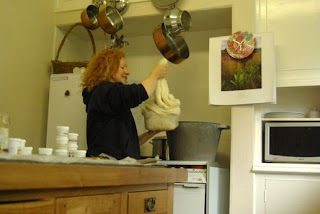
(Please excuse the crappy image quality, I took this with my camera phone just as I was about to leave for work.)
I sewed the first of the two seams together last night. On the right is the third panel of fabric, just sitting on the blanket, on the left is the seam I sewed, which hasnot yet been pressed. It took me hours to sew 2.5 m of "invisible" seam by hand (I'll never make the seam truly invisible in a fabric as highly patterned as this). I was very careful to ensure that the patterns of the braided twill matched up across the seam, even in places where the beat wasn't precisely even. I finished right on bedtime, so decided to leave it until tomorrow to do the next one. And then I had a flap.
My partner has a 30 kg luggage allowance for the flight into the base, and this blanket is going to weigh several kilos. It was much too late in the year to ship it down, and the ship won't get in for a full six weeks after he gets there anyway. The blanket has to be large enough to wrap around a full-sized, 6'1" male and not fall off the side of a single bunk. Conversely, it's going over a single bunk and has to be carried down - so I don't want it too large.
The first two panels together just covered the top of my small, antique double bed. Was that the place to stop, considering I haven't washed this yet so shrinkage has to be considered? I slept on it.
With a fresh mind this morning, I pulled out the tape measure. Each panel, 33" in the reed, has come down to 30" wide off the loom. I cut them to 2.6 m (110") long, considering the sheer height of said recipient. A typical single blanket measures 66 x 90" and a double 80 x 90". Three panels, sewn together and hemmed, will measure 90 x 100ish", before washing, with an estimated 10% shrinkage based on the samples.
So I'll be sewing that second seam tonight.
The good news? 8.5 m of fabric, and not one dropped or broken thread, missed warp or other error. Despite the tangles getting this warp on the loom, the tension remained even through the whole weaving. Also, I'm also very pleased with the way the variegations in colour have been carrying across the seams.














